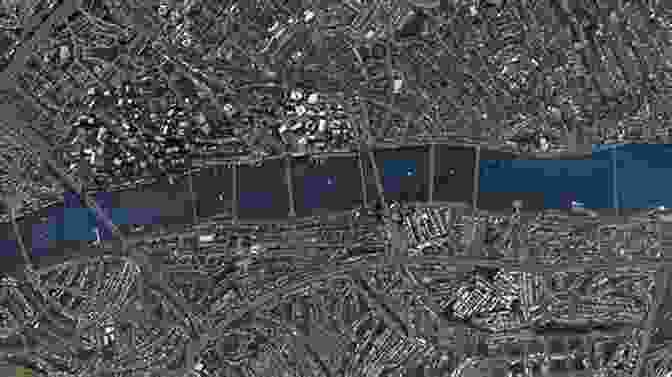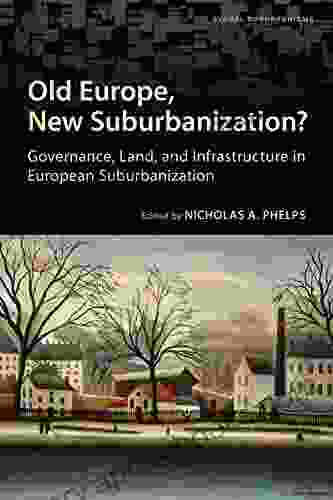Old Europe, New Suburbanization: Unraveling the Transformation of Europe's Cities


Europe, with its rich history and diverse urban landscapes, is undergoing a remarkable transformation. The traditional image of densely populated cities with centuries-old architecture is being challenged by a growing phenomenon: suburbanization.
4 out of 5
| Language | : | English |
| File size | : | 13253 KB |
| Text-to-Speech | : | Enabled |
| Enhanced typesetting | : | Enabled |
| Print length | : | 277 pages |
| Screen Reader | : | Supported |
Suburbanization, the movement of people and businesses from urban centers to suburban areas, is a global trend that has significantly impacted the shape and character of European cities. In this article, we will delve into the intricate web of factors driving suburbanization in Europe, examining its historical roots, current trends, and far-reaching implications.
Historical Evolution of European Suburbanization
The seeds of suburbanization in Europe were sown during the Industrial Revolution, as industrial centers grew rapidly, attracting a vast influx of workers. The urban population swelled, leading to overcrowding, poor sanitation, and social unrest.
In response to these challenges, the middle and upper classes began to seek refuge in郊外, where they could enjoy healthier living conditions, open spaces, and a sense of community. The development of railways and other transportation networks accelerated this exodus, making it easier to commute to work while living away from the hustle and bustle of the city.
After World War II, suburbanization gained further momentum. Economic growth, rising incomes, and the proliferation of automobiles fueled the construction of large-scale suburbs, often on the outskirts of major cities. The post-war era also witnessed the rise of modern planning concepts, which emphasized the separation of residential, industrial, and commercial zones.
Current Trends in Suburbanization
Today, suburbanization remains a defining feature of European urban landscapes. However, its nature and extent vary significantly across countries.
- Southern Europe: Suburbanization has been particularly pronounced in southern European countries such as Italy, Spain, and Portugal. Warm climates, affordable housing, and the desire for a Mediterranean lifestyle have attracted people to the suburbs.
- Western Europe: In Western Europe, suburbanization has reached a more mature stage. In countries like the United Kingdom, France, and Germany, the suburbs have become well-established, with strong infrastructure and a mix of residential, commercial, and industrial development.
- Eastern Europe: In Eastern Europe, suburbanization is a relatively recent phenomenon. After the fall of communism, many people moved from state-owned apartments in urban areas to newly built suburbs.
Impacts of Suburbanization in Europe
Social Impacts
Suburbanization has had a profound impact on European societies.
- Social Segregation: The movement to the suburbs has contributed to the segregation of populations by income, class, and ethnicity. Wealthier families tend to settle in more affluent suburbs, while lower-income households are often confined to older, less desirable urban areas.
- Changing Lifestyles: Suburban life offers a different lifestyle than urban living, characterized by a greater emphasis on家庭生活, individualism, and private space.
- Community: While suburbs offer a sense of community, they can also lead to social isolation and a decline in civic engagement.
Economic Impacts
Suburbanization has significant economic implications.
- Urban Sprawl: The uncontrolled expansion of suburbs has led to urban sprawl, resulting in the inefficient use of land and increased transportation costs.
- Infrastructure Costs: The development of new suburbs requires substantial investments in infrastructure, such as roads, schools, and utilities.
- Economic Vitality: The shift of businesses and residents to the suburbs can undermine the economic vitality of city centers.
Environmental Impacts
Suburbanization also poses environmental challenges.
- Air Pollution: The increased reliance on cars in suburban areas contributes to air pollution.
- Habitat Loss: The expansion of suburbs into green spaces leads to habitat loss for wildlife.
- Resource Consumption: Suburban living generally requires more resources, such as water and energy, than urban living.
Managing Suburbanization in Europe
Addressing the challenges posed by suburbanization requires a multifaceted approach.
- Smart Growth: Governments can promote smart growth policies that encourage compact, mixed-use development and reduce urban sprawl.
- Public Transportation: Investing in public transportation can reduce car dependency and promote alternative modes of commuting.
- Revitalizing City Centers: Cities can focus on revitalizing their urban centers to make them more attractive places to live, work, and spend leisure time.
- Green Infrastructure: Incorporating green infrastructure into suburban developments can mitigate environmental impacts and improve quality of life.
The suburbanization of Europe is a complex and ongoing phenomenon that is reshaping the continent's urban landscapes. It has brought about significant social, economic, and environmental changes, both positive and negative.
To manage suburbanization effectively, policymakers must adopt innovative and balanced approaches that promote sustainable development, enhance social equity, and preserve the unique character of European cities. By embracing smart growth strategies, investing in infrastructure, and revitalizing urban centers, Europe can create more vibrant, inclusive, and sustainable communities for the future.
4 out of 5
| Language | : | English |
| File size | : | 13253 KB |
| Text-to-Speech | : | Enabled |
| Enhanced typesetting | : | Enabled |
| Print length | : | 277 pages |
| Screen Reader | : | Supported |
Do you want to contribute by writing guest posts on this blog?
Please contact us and send us a resume of previous articles that you have written.
 Book
Book Novel
Novel Page
Page Chapter
Chapter Text
Text Story
Story Genre
Genre Reader
Reader Library
Library Paperback
Paperback E-book
E-book Magazine
Magazine Newspaper
Newspaper Paragraph
Paragraph Sentence
Sentence Bookmark
Bookmark Shelf
Shelf Glossary
Glossary Bibliography
Bibliography Foreword
Foreword Preface
Preface Synopsis
Synopsis Annotation
Annotation Footnote
Footnote Manuscript
Manuscript Scroll
Scroll Codex
Codex Tome
Tome Bestseller
Bestseller Classics
Classics Library card
Library card Narrative
Narrative Biography
Biography Autobiography
Autobiography Memoir
Memoir Reference
Reference Encyclopedia
Encyclopedia Paul Ireland
Paul Ireland Sonia Purnell
Sonia Purnell Mark Berry
Mark Berry Lucy Tempest
Lucy Tempest Rimma Mykhailovska
Rimma Mykhailovska Marcella Dipaolo
Marcella Dipaolo Susan B Hassmiller
Susan B Hassmiller Martin Kalb
Martin Kalb Matthew Levendusky
Matthew Levendusky Peter Wortsman
Peter Wortsman Mark Warner
Mark Warner Oscar Wilde
Oscar Wilde Sam Sykes
Sam Sykes Wojciech Sadurski
Wojciech Sadurski Susan Wiggs
Susan Wiggs Mary E Guy
Mary E Guy Olena Rose
Olena Rose Valerie Hannon
Valerie Hannon Penny Henderson
Penny Henderson Kristina Seleshanko
Kristina Seleshanko
Light bulbAdvertise smarter! Our strategic ad space ensures maximum exposure. Reserve your spot today!

 Darrell PowellArtificial Intelligence and Mobile Services: A Journey to Transformational...
Darrell PowellArtificial Intelligence and Mobile Services: A Journey to Transformational...
 Quincy WardThe Administrative State Challenge to Constitutional Government: A Must-Read...
Quincy WardThe Administrative State Challenge to Constitutional Government: A Must-Read...
 Raymond ChandlerIgnite Excitement for Reading: A Comprehensive Guide to Library Programs That...
Raymond ChandlerIgnite Excitement for Reading: A Comprehensive Guide to Library Programs That... Bo CoxFollow ·6.7k
Bo CoxFollow ·6.7k Robert BrowningFollow ·4.6k
Robert BrowningFollow ·4.6k Camden MitchellFollow ·12.8k
Camden MitchellFollow ·12.8k Blake KennedyFollow ·14.8k
Blake KennedyFollow ·14.8k Dawson ReedFollow ·14.8k
Dawson ReedFollow ·14.8k Cortez ReedFollow ·3.6k
Cortez ReedFollow ·3.6k Warren BellFollow ·11.5k
Warren BellFollow ·11.5k Melvin BlairFollow ·17k
Melvin BlairFollow ·17k

 Jorge Luis Borges
Jorge Luis BorgesUnlock Your Inner Musician: The Ultimate Guide to...
Embark on a Musical...

 Carlos Drummond
Carlos DrummondQuick Reference Guide To Percussion Instruments And How...
Unleash your inner rhythm with...

 Roberto Bolaño
Roberto BolañoUnlock Your Guitar Potential: The Ultimate Guitar Mastery...
Are you ready...

 Fred Foster
Fred FosterLooking for Lady Dee: A Punk Rock Mystery
By [Author's Name] Looking for Lady Dee is...

 Jacques Bell
Jacques BellJourney into the Mystical Realm of "Heaven Polly Alice...
In the tapestry of literature, where...

 Julio Ramón Ribeyro
Julio Ramón RibeyroSixty Years of Hits: A Musical Journey Through Time
Music has the...
4 out of 5
| Language | : | English |
| File size | : | 13253 KB |
| Text-to-Speech | : | Enabled |
| Enhanced typesetting | : | Enabled |
| Print length | : | 277 pages |
| Screen Reader | : | Supported |





